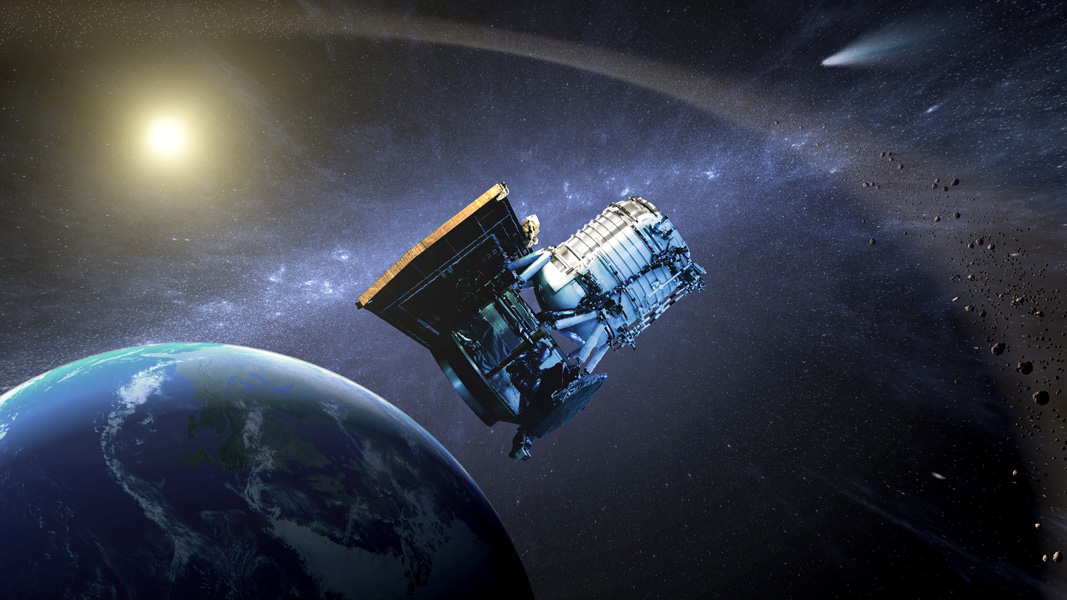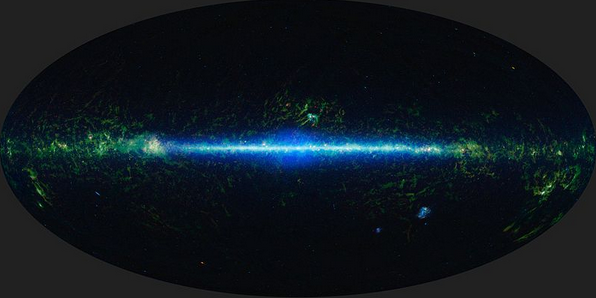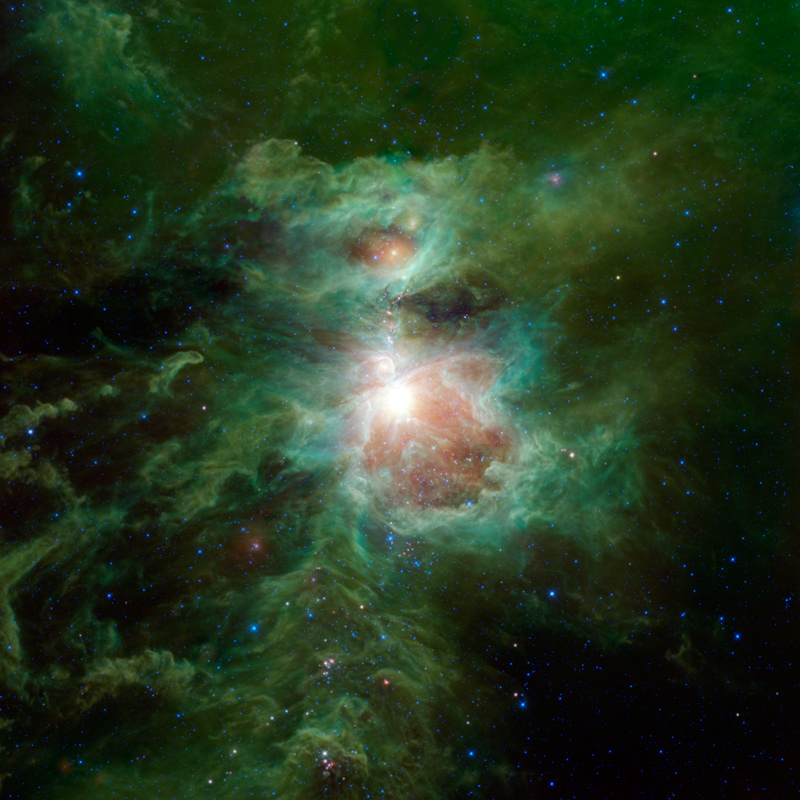Hunt for asteroids: Decommissioned WISE spacecraft to be reactivated as asteroid hunter

A NASA spacecraft that discovered and characterized tens of thousands of asteroids throughout the solar system before being placed in hibernation will return to service for three more years starting in September 2013. It will again be assisting in effort to identify the population of potentially hazardous near-Earth objects, as well as those suitable for asteroid exploration missions and sending humans to asteroid scheduled by 2025.
The Wide-field Infrared Survey Explorer (WISE) will be revived next month with the goal of discovering and characterizing near-Earth objects (NEOs), space rocks that can be found orbiting within 28 million miles (45 million kilometers) from Earth's path around the sun. NASA anticipates WISE will use its telescope and infrared cameras to discover about 150 previously unknown NEOs and characterize the size, albedo and thermal properties of about 2,000 others – including some which could be candidates for the agency's recently announced asteroid initiative.
WISE was launched on December 14, 2009, to look for the glow of celestial heat sources from asteroids, stars and galaxies, and made about 7,500 images every day during its primary mission, from January 2010 to February 2011. It was decommissioned (hibernated) on February 17, 2011 when its transmitter was turned off. It performed an all-sky astronomical survey with images in 3.4, 4.6, 12 and 22 μm wavelength range bands, over 10 months using a 40 cm (16 in) diameter infrared telescope in Earth-orbit. In October 2010 its hydrogen coolant was depleted, but a four-month mission extension called NEOWISE was conducted to search for small solar system bodies close to Earth's orbit (e.g. hazardous comets and asteroids) using remaining capability.
"The WISE mission achieved its mission's goals and as NEOWISE extended the science even further in its survey of asteroids. NASA is now extending that record of success, which will enhance our ability to find potentially hazardous asteroids, and support the new asteroid initiative," said John Grunsfeld, NASA's associate administrator for science in Washington. "Reactivating WISE is an excellent example of how we are leveraging existing capabilities across the agency to achieve our goal."
NASA's asteroid initiative will be the first mission to identify, capture and relocate an asteroid. It represents an unprecedented technological feat that will lead to new scientific discoveries and technological capabilities that will help protect our home planet. The asteroid initiative brings together the best of NASA's science, technology and human exploration efforts to achieve President Obama's goal of sending humans to an asteroid by 2025.
"The data collected by NEOWISE two years ago have proven to be a gold mine for the discovery and characterization of the NEO population," said Lindley Johnson, NASA's NEOWISE program executive in Washington. "It is important that we accumulate as much of this type of data as possible while the WISE spacecraft remains a viable asset."
Because asteroids reflect but do not emit visible light, infrared sensors are a powerful tool for discovering, cataloging and understanding the asteroid population. Depending on an object's reflectivity, or albedo, a small, light-colored space rock can look the same as a big, dark one. As a result, data collected with optical telescopes using visible light can be deceiving.
During 2010, NEOWISE observed about 158,000 rocky bodies out of approximately 600,000 known objects. Discoveries included 21 comets, more than 34,000 asteroids in the main belt between Mars and Jupiter, and 135 near-Earth objects.
All sky data
On April 14, 2011, a preliminary release of WISE data was made public, covering 57 percent of the sky observed by the spacecraft. On March 14, 2012, a new atlas and catalog of the entire infrared sky as imaged by WISE was released to the astronomic community. On July 31, 2012 NEOWISE Post-Cryo Preliminary Data was released. A release called AllWISE, combining all data, was approved.

This is a mosaic of the images covering the entire sky as observed by the WISE. It is a part of its All-Sky Data Release.
The sky can be thought of as a sphere that surrounds us in three dimensions. To make a map of the sky, astronomers project it into two dimensions. Many different methods can be used to project a spherical surface into a 2-D map. The projection used in this image of the sky, called Aitoff, takes the 3-D sky sphere and slices open one hemisphere, and then flattens the whole thing out into an oval shape.
In the mosaic, the Milky Way Galaxy runs horizontally across this map. The Milky Way is shaped like a disk and our solar system is located in that disk about two-thirds of the way out from the center. So we see the Milky Way as a band running through the sky. As we look toward the center of the galaxy, we are looking through more of the disk than when we are looking at large angles away from the center, and you can see a noticeable increase in stars (colored blue-green) toward the center of the image.
There are some artifacts worth noting in the image. For the image atlas, moving objects such as asteroids and comets were removed. However, some slower moving, bright objects did leave behind residuals. Residuals of the planets Saturn, Mars, and Jupiter are visible in this image as bright red spots off the plane of the Galaxy at the 1:00, 2:00 and 7:00 positions, respectively. In addition, at several locations in the image there are small rectangular shaped features that result from the difficulty in matching background levels of individual atlas frames.
Three of the four wavelengths surveyed by WISE were used to create this image. The colors used in this image represent specific wavelengths of infrared light. Cyan (blue-green) represents light emitted predominantly from stars and galaxies at a wavelength of 3.4 microns. Green and red represent light mostly emitted by dust at 12 and 22 microns, respectively. Credit:NASA/JPL-Caltech/UCLA
Click here to download the high resolution tiff file (300 MB)
Orion nebula

The Great Nebula in Orion is featured in this image. The constellation of Orion is prominent in the evening sky throughout the world from about December through April of each year. The Orion Nebula (also catalogued as Messier 42) is located in the sword of Orion, hanging from his famous belt of three stars. The star cluster embedded in the nebula is visible to the unaided human eye as a single star, with some fuzziness apparent to the most keen-eyed observers. Because of its prominence, cultures all around the world have given special significance to Orion. The Maya of Mesoamerica envision the lower portion of Orion, his belt and feet (the stars Saiph and Rigel), as being the hearthstones of creation, similar to the triangular three-stone hearth that is at the center of all traditional Maya homes. The Orion Nebula, lying at the center of the triangle, is interpreted by the Maya as the cosmic fire of creation surrounded by smoke.
The metaphor of a cosmic fire of creation is apt. The Orion Nebula is an enormous cloud of dust and gas where vast numbers of new stars are being forged. It is one of the closest sites of star formation to Earth and therefore provides astronomers with the best view of stellar birth in action. Many other telescopes have been used to study the nebula in detail, finding wonders such as planet-forming disks around newly forming stars. WISE was an all-sky survey giving it the ability to see these sites of star formation in a larger context. This view spans more than six times the width of the full Moon, covering a region nearly 100 light-years across. In it, we see the Orion Nebula surrounded by large amounts of interstellar dust, colored green.
Astronomers now realize that the Orion Nebula is part of the larger Orion molecular cloud complex, which also includes the Flame Nebula. This complex in our Milky Way Galaxy is actively making new stars. It is filled with dust warmed by the light of the new stars within, making the dust glow in infrared light.
Color in this image represents specific infrared wavelengths. Blue represents light emitted at 3.4-micron wavelengths and cyan (blue-green) represents 4.6 microns, both of which come mainly from hot stars. Relatively cooler objects, such as the dust of the nebulae, appear green and red. Green represents 12-micron light and red represents 22-micron light. Image Credit: NASA/JPL-Caltech/WISE Team
Pointing a finger at star formation
.jpg)
WISE captured this image of a star-forming cloud of dust and gas located in the constellation of Monoceros. The nebula, commonly referred to as Sh2-284, is relatively isolated at the very end of an outer spiral arm of our Milky Way galaxy. In the night sky, it's located in the opposite direction from the center of the Milky Way.
Perhaps the most interesting features in Sh2-284 are what astronomer call "elephant trunks." Elephant trunks are monstrous pillars of dense gas and dust. The most famous examples of are the "Pillars of Creation," found in an iconic image of the Eagle nebula from NASA's Hubble Space Telescope. In this WISE image, the trunks are seen as small columns of gas stretching towards the center of the void in Sh2-284, like little green fingers with yellow fingernails. The most notable one can be seen on the right side of the void at about the 3 o'clock position. It appears as a closed hand with a finger pointing towards the center of the void. That elephant trunk is about 7 light-years long.
Deep inside Sh2-284 resides an open star cluster, called Dolidze 25, which is emitting vast amounts of radiation in all directions, along with stellar winds. These stellar winds and radiation are clearing out a cavern inside the surrounding gas and dust, creating the void seen in the center. The bright green wall surrounding the cavern shows how far out the gas has been eroded. However, some sections of the original gas cloud were much denser than others, and they were able to resist the erosive power of the radiation and stellar winds. These pockets of dense gas remained and protected the gas "downwind" from them, leaving behind the elephant trunks. These pillars can also be thought of as rising like stalagmites from the cavern walls.
The Sh2-284 nebula is classified as an HII region, as is LBN 114.55+00.22 featured in the September 16, 2010 image. HII regions go hand in hand with star formation, and indeed the stars in the central Dolidze 25 cluster have just recently formed. They're hot, young, bright stars, with ages ranging from 1.5 to 13 million years — infants by astronomical standards. In comparison, the sun is about 4.6 billion years old.
The colors used in this image represent specific wavelengths of infrared light. Blue and cyan (blue-green) represent light emitted at wavelengths of 3.4 and 4.6 microns, which is predominantly from stars. Green and red represent light from 12 and 22 microns, respectively, which is mostly emitted by dust. Image credit: NASA/JPL-Caltech/UCLA
Mission videos





- WISE mission site
- More images are here and here
- More movies and simulations
- NASA's WISE mission page
Featured image: This artist's concept shows the Wide-field Infrared Survey Explorer, or WISE spacecraft, in its orbit around Earth. In September of 2013, engineers will attempt to bring the mission out of hibernation to hunt for more asteroids and comets in a project called NEOWISE. Image credit: NASA/JPL-Caltech

It’s said that “NASA’s hibernating spacecraft AKA satellite” will emerge from a scheduled "hibernation" and return to service to look for potentially hazardous near-Earth objects …. But wouldn’t it be awesome if there were celestial secrets hidden beyond the veil where these so called asteroids were actually “celestial hibernating spacecrafts”… which for some reason are now becoming activated in deep space, and their awakening are prompting the “NASA’s hibernating spacecraft satellite” to be reactivated in order to look out for heat glowing signs identifying which celestial asteroids AKA spacecraft are waking up … as to identify any potential incoming … “Space seems to be waking up in more ways than one” …..